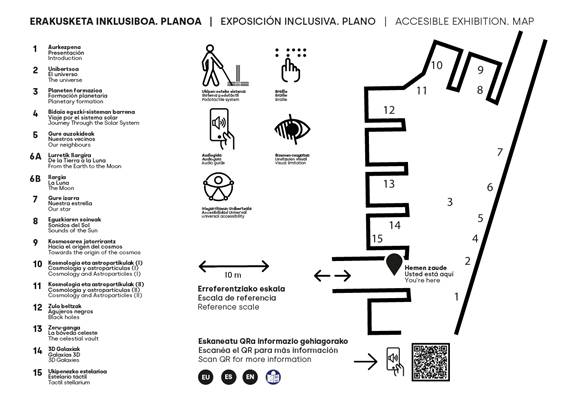Welcome to ‘STROM – Inclusive Astronomy’. One of the main aims of this exhibition is to ensure accessibility, understood as the removal of barriers for disabled people, especially with visual, hearing or physical disabilities. The inclusive materials for this exhibition have been created with guidance from institutions and professionals who work with collectives of disabled people.

Before you start the tour, we recommend you take a moment to get to know the accessibility systems used at the exhibition. In front of each explanatory panel, a touch screen shows basic information in Braille about where we are. Certain embossed QR codes provide us with access to an auditory and visual audio guide which provides further information about each section, which is available in Basque, Spanish and English, as well as in an easy-reading mode. To access the audio guide, point the camera on your mobile phone or electronic device at the QR code, press on the link that appears on the screen, select the language, and then choose the visual or auditory option on the audio guide.
Next to this first panel, you will also find a tactile map of the two exhibition halls.
We recommend that you take the tour round the exhibition in a clockwise direction. This route is marked out by embossed guides and podo-tactile warnings on the floor that will guide you through each section from the entrance to the exit.

If you are in front of the map, you will see that the first room is rectangular. This room is devoted to our solar system. Spaces devoted to its formation, its composition and to the scale and distances between the planets are shown. We will also be able to feel the texture of the different types of planets, we will have to guess the real distance between the Earth and the Moon, and we will listen to the sounds of the different layers of the Sun, represented by a large sphere, 3.3 metres in diameter which dominates the room and around which the planets in the solar system hang.
The room 2 invites us to explore the outer reaches of the known universe. Various projects that are being carried out on cosmology and astro-particles are shown: the origin of galaxies, dark matter, neutrinos, a black hole and the constellations in the celestial vault.
The exhibition has no physical barriers that may impede access and moving around in a wheelchair. If you should need one, there is a wheelchair available in the exhibition hall.
Turn left and follow the podo-tactile guide until you come to point 1 in the tour. At each point in the tour, you will find a tactile exhibit label with a QR that will provide you with access to information about each installation.
We hope you enjoy the experience.